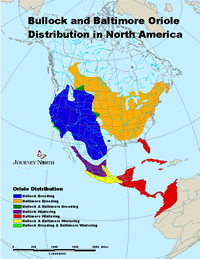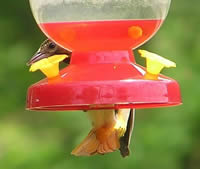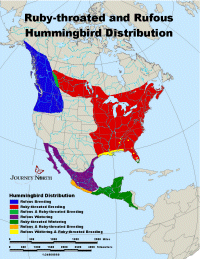Highlights
from the Migration Trail
What Can You Learn
from Observers?
(Back to Today's
Update - May 8, 2008)
Who
is this stranger drinking from the hummingbird feeder? Click
to enlarge. Then read on! Photo:
© Jean English |
What can you learn about migrations from other observers? Read these reports, then discuss the question at the end.
Belleville, Michigan: My daughter spotted our first male hummingbird today. Aahhh, spring is officially here! I'm also excited to report that we also have a male Baltimore oriole hanging around and using the hummer feeders!
Fulton, Michigan: It was exciting enough to have the first oriole here this morning. But then at 5 p.m. we had our first rubythroat.
Rochester, Minnesota: The orioles and rose-breasted grosbeaks arrived yesterday and today I saw the first male hummingbird of the season.
Middleboro, Massachusetts: One lone hummingbird drinking nectar out of my oriole feeder!
Think: What do you think ruby-throated hummingbirds and Baltimore orioles have in common?
Dig Deeper: Once you've answered, look at these facts about hummingbirds and orioles. What more would you add to your answer? Why do you think they arrive up north about the same time?
| Ruby-throated
Hummingbirds |
Baltimore
Orioles |
 |
|
| Enlarge:
The red shows the ruby-throated hummingbird's breeding range. (The
green shows its winter range.) |
Enlarge:
The gold shows the Baltimore oriole's breeding range. (The red shows
its winter range.) |
| What
They Eat (Diet) |
|
| Insects,
flower nectar |
Insects,
flower nectar, small fruits |
| Where
They Live (Habitat) |
|
| Wooded
areas, suburban parks and gardens, near streams |
Wooded
areas, suburban areas with shade trees, near streams |
| Migration
Notes |
|
| Cross
the Gulf of Mexico on journey north from Central America. |
Cross
the Gulf of Mexico on journey north from Central America. |
| Take
8-10 weeks to migrate north. |
Take
2-3 weeks to migrate north. They make a big push once leaves come
out. |
| Can
eat many types of tiny flying insects and sap from sapsucker holes.
So even in unpredictable weather on their long migration, they can
find food. |
Require
much larger insects, like caterpillars. These don't hatch until
leaves come out. So orioles wait until then, and then make a fast
final push north. |
| Rubythroats arrive in northern breeding grounds about the same time as orioles: When food sources are available there. | Orioles arrive in northern breeding grounds about the same time as rubythroats: When food sources are available there. |




